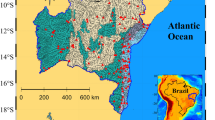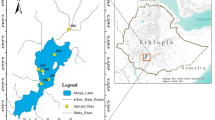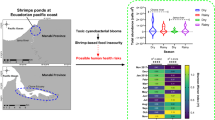Abstract
The aim of the study was to estimate the impact of oxygen depletion on macroinvertebrate community structure in benthic space. Macroinvertebrate assemblages and potential of dissolved oxygen (DO) consumption were investigated simultaneously in the plain rivers of the Ziya River Basin. The degree of DO depletion was represented by sediment oxygen demand (SOD) and DO, chemical oxygen demand (CODCr), and ammonia nitrogen (NH4 +-N) in the overlying water. The results showed an all-around hypoxia environment formed, and the values of DO, SOD, CODCr, and NH4 +-N were separately 0.11–4.03 mg L−1, 0.41–2.60 g m−2 day−1, 27.50–410.00 mg L−1, and 1.79–101.41 mg L−1. There was an abnormal macroinvertebrate assemblage, and only 3 classes, Insecta, Gastropoda, and Oligochaeta, were found, which included 9 orders, 30 families, and 54 genera. The biodiversity was at a low level, and Shannon-Wiener index was 0.00–1.72. SOD, and NH4 +-N had major impact on the macroinvertebrate community, and the former had negative effect on most taxa, for instance, Nais, Branchiura, Paraleptophlebia, etc., which were sensitive or had a moderate-high tolerance to pollution. NH4 +-N had both positive and negative impacts on benthic animals, for instance, Dicrotendipes, Gomphus, Cricotopus, etc., for the former, and Procladius, Limnodrilus, Hippeutis, etc., for the latter. They all had a moderate-high tolerance to pollution. It is significant to improve DO condition and macroinvertebrate diversity in river harnessing and management.




Similar content being viewed by others
References
Aguiar ACF, Gücker B, Brauns M, Hille S, Boëchat IG (2015) Benthic invertebrate density, biomass, and instantaneous secondary production along a fifth-order human-impacted tropical river. Environ Sci Pollut Res 22:9864–9876
Antanasijevic D, Pocajtb V, Perić-Grujićb RM (2014) Modelling of dissolved oxygen in the Danube River using artificial neural networks and Monte Carlo simulation uncertainty analysis. J Hydrol 519:1895–1907
Bu HM, Meng W, Zhang Y (2011) Nitrogen pollution and source identification in the Haicheng River basin in Northeast China. Sci Total Environ 409(18):3394–3402
Chen XH, Gao W, Liu WL, Sun CJ, Kang LJ (2013) Characteristics of macrobenthos community structure and its relationship to environmental factors within a typical plain river network. Ecol Environ Sci (in Chinese) 22(8):1310–1316
Comte L, Lek S, de Deckere E, de Zwart D, Gevrey M (2010) Assessment of stream biological responses under multiple-stress conditions. Environ Sci Pollut Res 17:1469–1478
Coysh J, Nichols S, Ransom G, Simpson J, Norris R, Barmuta L, Chessman B (2000) AUSRIVAS macroinvertebrate bioassessment predictive modelling manual. Cooperative Research Centre for Freshwater Ecology, Canberra
Ekau W, Auel H, Poertner HO, Gilbert D (2010) Impacts of hypoxia on the structure and processes in pelagic communities (zooplankton, macro-invertebrates and fish). Biogeosciences 7(5):1669–1699
Fu XC, Ye L, Xu YY, Cai QH (2010) Survey of water quality and benthos in the Yellow River Basin. Ecol Sci (in Chinese) 29(1):001–007
Gao HY, Zhuang X, Zhang Q (2011) Temporal and spatial change of non-point source nitrogen pollution in Le′an river catchment of Poyang Lake. Resour Environ Yangtze Basin (in Chinese) 20(5):597–602
Grieshaber MK, Hardewig I, Kreutzer U, Poertner HO (1994) Physiological and metabolic responses to hypoxia in invertebrates. Rev Physiol Bioch P 125:43–147
Hanes N, Irvine RL (1966) Oxygen uptake rates of benthal systems by a new technique. Proceedings of the 21st Industrial Waste Conference: 468–479
Heatherly TII, Whiles MR, Royer TV, David MB (2007) Relationships between water quality, habitat quality, and macroinvertebrate assemblages in Illinois streams. J Environ Qual 36(6):1653–1660
Hering D, Moog O, Sandin L, Verdonschot PFM (2004) Overview and application of the AQEM assessment system. Hydrobiologia 516(1–3):1–20
Hickey CW (1988) Benthic chamber for use in rivers-testing against oxygen mass balances. J Environ Eng-Asce 114(4):1653–1660
Hilsenhoff WL (1998) Rapid field assessment of organic pollution. J T N Am Benthol Soc 7(1):65–68
Holland A, Duivenvoorden LJ, Kinnear SHW (2015) Effect of key water quality variables on macroinvertebrate and fish communities within naturally acidic wallum streams. Mar Freshwater Res 66(1):50–59
Hu WF, Lo W, Chun H, Sin SN, Yu PH (2001) Nutrient release and sediment oxygen demand in a eutrophic land-locked embayment in Hong Kong. Environ Int 26(5):369–375
Huo TB, Liu MH, Jiang ZF, Li Z, Ma B, Yu HX (2012) Macrobenthos community structure of macrobenthos and bioassessment of water quality in main stream of Songhua River. Chin J Appl Ecol 23(1):247–254
Irving EC, Liber K, Culp JM (2004) Lethal and sublethal effects of low dissolved oxygen condition on two aquatic invertebrates, Chironomus tentans and Hyalella azteca. Environ Toxicol Chem 23(6):1561–1566
James A (1974) The measurement of benthal respiration. Water Res 8(11):955–959
Jiang WX, Lai ZN, Peng SY, Gao Y, Yang WL, Pang SX (2011) Primary study of macroinvertebrate community structure in the pearl river Guangzhou portion. Environmental Monitoring in China 27(5):69–72
John CM, Yang LF, Tian LX (1994) Aquatic insects of China useful for monitoring water quality. Hohai University Press, Nan**g
Justus BG, Mize SV, Wallace J, Kroes D (2014) Invertebrate and fish assemblage relations to dissolved oxygen minima in lowland streams of southwestern Louisiana. River Res Appl 30(1):11–28
Kerans BL, Karr JR (1994) A Benthic Index of Biotic Integrity (B-IBI) for rivers of the Tennessee Valley. Ecol Appl 4:768–785
Lassaletta L, Garcia-Gomez H, Gimeno BS, Rovira JV (2010) Headwater streams: neglected ecosystems in the EU Water Framework Directive. Implications for nitrogen pollution control. Environ Sci Policy 13(5):423–433
Lenat DR (1993) A biotic index for the southeastern United States derivation and list of tolerance values, with criteria for assigning water-quality ratings. J N Am Benthol Soc 12(3):279–290
Lepx J, Smilauer P (2003) Multivariate analysis of ecological data using CANOCO. Cambridge University Press, Cambridge
Leunda PM, Oscoz J, Miranda R (2009) Longitudinal and seasonal variation of the benthic macroinvertebrate community and biotic indices in an undisturbed Pyrenean river. Ecol Indic 9:52–63
Li WZ, Li XY, Wang HL, Su JJ (2012) Spatial distribution of the main contaminations in aquatic environment in Fuyang River. Acta Sci Circumstantiae (in Chinese) 32(11):2814–2819
Liu XB, Li GF, Liu ZG, Guo WH, Gao NY (2010) Water pollution characteristics and assessment of lower reaches in Hai River Basin. Procedia Environ Sci 02:199–206
Liu WC, Chen WB, Kimura N (2009) Measurement of sediment oxygen demand to simulate dissolved oxygen distribution: case study in the Main Danshuei River Estuary. Environ Eng Sci 26(12):1701–1711
Liu YY, Zhang WZ, Wang YX (1979) Economic animals in China, freshwater mollusks. Science Press, Bei**g
Maul JD, Farris JL, Milam CD, Cooper CM, Testa S, Feldman DL (2004) The influence of stream habitat and water quality on macroinvertebrate communities in degraded streams of northwest Mississippi. Hydrobiologia 518(1–3):79–94
McNeil DG, Closs GP (2007) Behavioural responses of a south-east Australian floodplain fish community to gradual hypoxia. Freshwater Biol 52(3):412–420
Nandan SB, Azis PKA (1995) Fish mortality from anoxia and sulphide pollution. J Hum Ecol 6(2):97–104
National Bureau of Statistics of the People’s Republic of China. Bulletin of the sixth national census of Hebei province in 2010
Rao YR, Howell T, Watson SB, Abernethy S (2014) On hypoxia and fish kills along the north shore of Lake Erie. J Great Lakes Res 40(1):187–191
Riedel B, Pados T, Pretterebner K, Schiemer L, Steckbauer A, Haselmair A (2014) Effect of hypoxia and anoxia on invertebrate behaviour: ecological perspectives from species to community level. Biogeosciences 11(6):1491–1518
Stambuk-Giljanovic N (2006) The pollution load by nitrogen and phosphorus in the Jadro River. Environ Monit Assess 123(1–3):13–30
State Environmental Protection Agency (2002) Method of monitoring and analysis of water and wastewater, 4th edn. China Environmental Science Press, Bei**g
Tang WZ, Mao ZP, Zhang H, Shan BQ, Zhao Y, Ding YK (2015) Water resources: the prerequisite for ecological restoration of rivers in the Hai River Basin, northern China. Environ Sci Pollut Res 22:1359–1365
The Editorial Board of Hai river (1997) The Hai River Basin, vol 1. China Water & Power Pres, Bei**g
Urbina MA, Glover CN (2012) Should I stay or should I go?: physiological, metabolic and biochemical consequences of voluntary emersion upon aquatic hypoxia in the scaleless fish Galaxias maculatus. J Comp Physiol B 182(8):1057–1067
Volpers M, Neumann D (2005) Tolerance of two tubificid species (Tubifex tubifex and Limnodrilus hoffmeisteri) to hypoxic and sulfidic conditions in novel, long-term experiments. Arch Hydrobiol 164(1):13–38
Wang BX, Yang LF (2004) A study on tolerance values of benthic macroinvertebrate taxa in eastern China. Acta Ecol Sin (in Chinese) 24(12):2768–2775
Wang C, Shan BQ (2012) The distribution of aerobic ammonia oxidizing microorganisms in Ziya River, Haihe Basin. Acta Sci Circumstantiae (in Chinese) 32(12):2943–2950
Wang JG, Huang HB, Yang MX (2003) Tolerance values of benthic macroinvertebrates and bioassessment of water quality in the Lushan Nature Reserve. Chin J Appl Environ Biol 9(3):279–284
Wright JF (1995) Development and use of a system for predicting macroinvertebrates in flowing waters. Austr J Ecol 20:181–197
Wu J, Yu ZM, Qian TM (2003) Studies on nitrogen pollution characteristics in Hangzhou section of the Qiantang river. Resour Environ Yangtze Basin (in Chinese) 12(6):552–556
**ng SW, Wang JC, Ding ZJ, Jiang YW (2012) Large benthonic invertebrates’ tolerance values and water quality evaluation in Liaoning Province. Environ Prot Sci (inChinese) 39(3):29–33
Zhang H, Ludsin SA, Mason DM, Adamack AT, Brandt SB, Zhang XS (2009) Hypoxia-driven changes in the behavior and spatial distribution of pelagic fish and mesozooplankton in the northern Gulf of Mexico. J Exp Mar Biol Ecol 381:S80–S91
Zhao W (2005) Aquatic biology. China Agriculture Press, Bei**g
Zhao Y, Shan BQ, Zhang WQ, Wang C (2014) Forms and spatial distribution characteristics of nitrogen in Ziya River Basin. Environ Sci 35(1):143–149
Zhu YQ (2014) Ecological situation and governing method of plain rivers in the Ziya River Basin. Water Conserv Hebei Province in China 04:38–39
Acknowledgments
Financial support was provided by the “National Water Pollution Control and Management Technology Major Projects of China (2012ZX07203-006)”. Seven people participated in the field work, but we especially thank engineer Xuehong Kong. Thanks are due to Dr. Juguang Wang and his assistants from College of Fisheries of Huazhong Agricultural University for the identification of macroinvertebrates.
Author information
Authors and Affiliations
Corresponding author
Additional information
Responsible editor: Philippe Garrigues
Rights and permissions
About this article
Cite this article
Ding, Y., Rong, N. & Shan, B. Impact of extreme oxygen consumption by pollutants on macroinvertebrate assemblages in plain rivers of the Ziya River Basin, north China. Environ Sci Pollut Res 23, 14147–14156 (2016). https://doi.org/10.1007/s11356-016-6404-z
Received:
Accepted:
Published:
Issue Date:
DOI: https://doi.org/10.1007/s11356-016-6404-z




